TUESDAY
SEPTEMBER 30 - 2014
BROOK
MEADOW
Malcolm's news
Malcolm
Phillips went round the meadow this morning and had a
couple of good sightings, first the Water Rail
and Kingfisher both at the S bend, but still no
photo of the Kingfisher.

Malcolm also got this
great shot of a Robin singing its heart out
near the S-bend.

The next stop was the
south bridge where Malcolm saw a Water Vole
just popping out of his burrow and got this quick
photo of it. This is probably the same vole that has
been seen several times before at this location. Are
there any others elsewhere, I wonder?
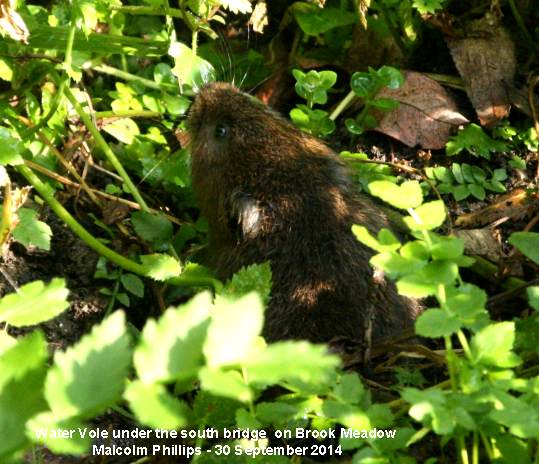
River
bank work
I had a stroll
through the meadow this afternoon. Had a chat with the
Environment Agency contractors. The wall is finished,
but they are having problems getting the posts into
the bank. They will need to get back to the
Environment Agency for further advice. I am not sure
why they need the posts. They stick up much taller
than the wall and are an eyesore.
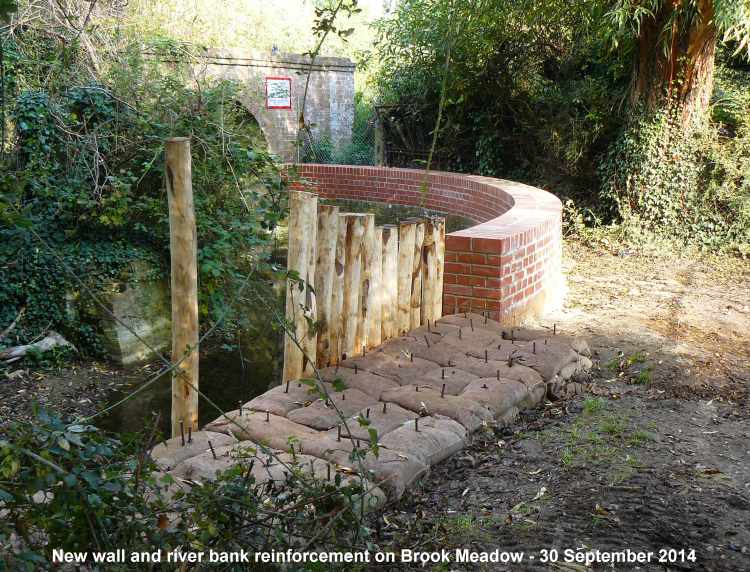
Wild
flowers
Most of the
Common Fleabane has now finished flowering leaving
just the brown seedheads. However, many other flowers
are still out including Hogweed, Red Clover, Bristly
Ox-tongue, Michaelmas Daisies, Wild Angelica, Water
Mint, Bindweed, White Dead-nettle, Water Forget-me-not
on river bank and Common Nettle. Particularly
impressive were both white and purple Common
Comfrey.
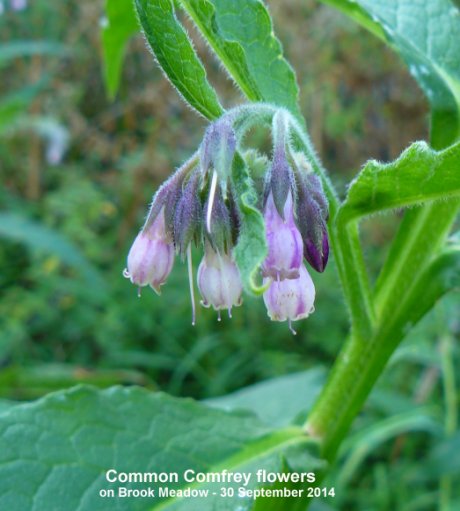
Also prominent on the
north meadow were newly flowering grasses, Cocksfoot
and False Oat-grass.
I found some late Timothy which was a surprise.
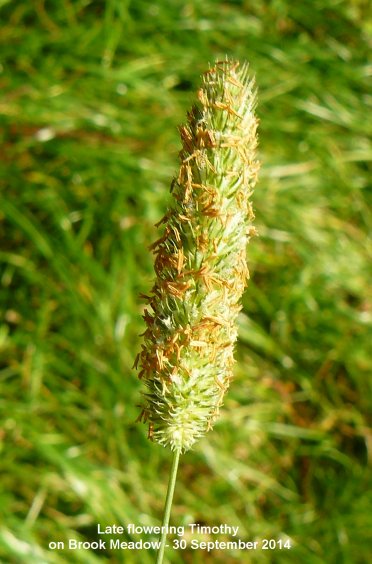
MONDAY
SEPTEMBER 29 - 2014
Emsworth
Harbour
I walked
around the harbour this morning on a rising tide. Very
little in the way of birds in the eastern harbour, but
the situation improved when I got to the western
harbour. I counted 92 Teal feeding in the
channels and on the mudflats, much the same as I have
seen here before. They were well spread out over the
harbour and it was good to hear their whistling calls
echoing over the mudflats. I found another 110
Teal south of Nore Barn, but much further out in
the harbour, making a grand total of 202 - the best
count this season. They were feeding with 13
Shelduck.
I counted a group of 94 Redshank roosting on
the south side of the main channel. They were too far
away to see leg rings.
Four Black-tailed Godwits flew in while I was
sitting on the bench at the end of Beach Road, none
had colour-rings.
The usual collection of 11 Mute Swans including one
brown cygnet were in the Nore Barn stream where one
Common Redshank was feeding. It's still a bit too
early for the Spotted Redshank.
Brook
Meadow Water Rail
Malcolm
Phillips had no time to go round the meadow today, but
did go round on Friday (Sep 26) and saw the Water Rail
and saw it again on Sunday (Sep 28). Malcolm's photo
from the rear clearly shows how slender the Water Rail
is, its body is laterally compressed enabling it to
slip easily through dense reeds with hardly a
movement.
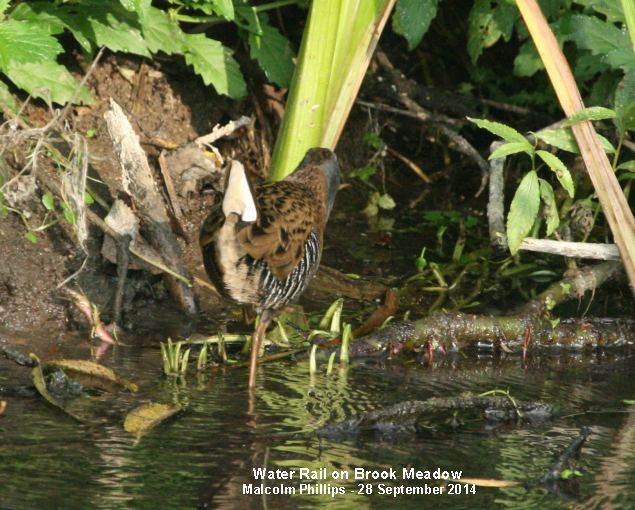
Havant
Water Voles
Passing Tesco
Havant on his regular cycle to Broadmarsh yesterday
morning Roy Ewing saw 2 adult Water Voles and one
juvenile simultaneously just north of the water wheel.
Crossing to the Dolphin pond, Roy spied a 4th which
seemed to have made a home in the branch pile in the
SW of the pond. It spent 5 minutes leaving its home,
circling and returning. An interesting display of some
ritual? With his luck in Roy walked the river at Brook
Meadow, but saw nothing. He has never seen a Water
Vole in Brook Meadow!
THURSDAY
SEPTEMBER 25 - 2014
Cormorant
with Eel
While passing
Peter Pond this morning, I watched a Cormorant catch
an Eel and struggle for several minutes, trying to
subdue and swallow it.
Near
the end of the road for the
Eel

Gulp.
Down it goes!
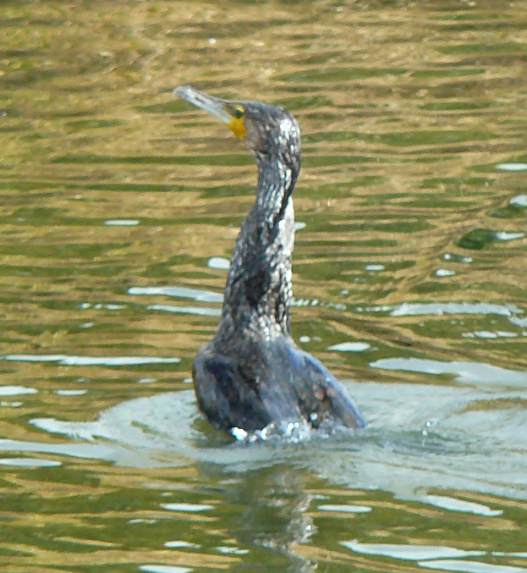
Sea
Trout parr?
From the
Hermitage Bridge I watched a shoal of small fish
accompanied by two larger fish. All the fish moved
around together almost like a family. The two larger
fish were not the regular Grey Mullett, but were
spotted like a Trout. I think all these are young
trout called 'parr'.
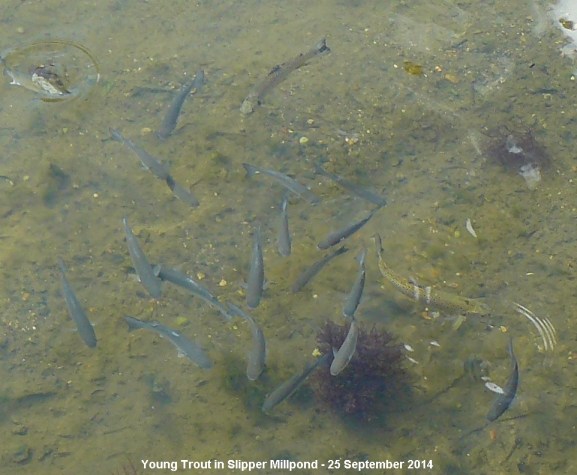
Water
Rail
Pam Phillips
saw the "tail end " of the Water Rail on the river
bank behind the Williams unit at 7.30am this morning.
Mystery
fungus
Chris Oakley
found this fungus growing in a ditch on the Hampshire
Farm site. He thought it looked like a bunch of
Yorkshire puddings. The caps look a bit like Honey
Fungus to me, though they appear to be growing on
straw which is the wrong habitat.

Barrel
Jellyfish
Ralph Hollins
provided the following information about the likely
identity of the large Jellyfish found on the west
Thorney shore by Maurice Lillie (blog for Sep 24).
"It seems likely that there may be more jellyfish
sightings around the Emsworth area and you and your
readers might like more background info on this year's
influx of Barrel Jellyfish along the south coast. To
see good illustrations of the species that can occur
in the English Channel see http://www.marine-conservation.org.uk/ukjellyfish.html
To see one in action
go to . . . http://www.telegraph.co.uk/earth/wildlife/10989852/Biggest-British-barrel-jellyfish-caught-on-camera.html
which starts with men swimming alongside one to
indicate size.
Another video at . . .
http://www.independent.co.uk/news/uk/giant-20kg-jellyfish-filmed-off-the-coast-of-cornwall-9567437.html
shows a dog swimming alongside a specimen said to
weigh 20 kg.
For local interest
this week see a photo of one beached on the south
Hayling shore - go to . . . http://www.haylingtoday.co.uk/news/local/barrel-jellyfish-pop-up-onto-the-beach-1-6320483
and for one in Portsmouth Harbour go to . . .
http://www.portsmouth.co.uk/news/giant-jellyfish-found-in-portsmouth-harbour-1-6316760
. . . Both these sightings appeared in the Portsmouth
News this week.
Finally Ralph reminded me that I published Chris
Cockburn's photo of one that he took at the Oysterbeds
on the blog for June 16.
Tussock
Moth caterpillar
Mike Wells was
at Queen Elizabeth Country Park on Tuesday morning (23
Sep) and saw this wonderful caterpillar, later
identified as a Pale Tussock moth. Mike just marvelled
at how nature could produce such a wonderful design,
but he was curious as to why evolution felt that it
needed four shaving brushes! The evolutionary purpose
of the 'shaving brushes' is almost certainly to do
with deterring predators, particularly birds, which
would get an unpleasant beakful if they attempted to
eat the caterpillar.

WEDNESDAY
SEPTEMBER 24 - 2014
BROOK
MEADOW
After the rain
I walked over to the meadow to have a look for the
Water Rail that Malcolm Phillips has seen for the past
two days by the S-bend. I waited and watched for 20
mins or so without seeing any sign of it, though an
active Moorhen was a distraction.
Here is a photo
of the rail that Malcolm got yesterday in the same
area.
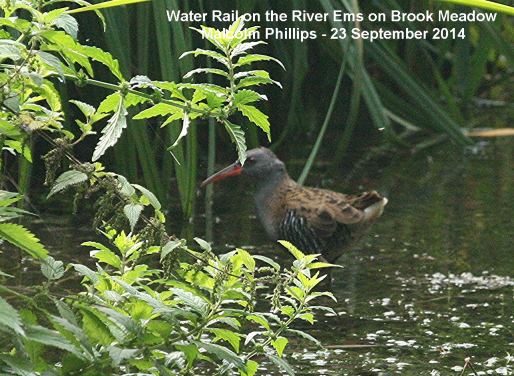
While watching for the
Water Rail I did have the pleasure of seeing a
Kingfisher fly past going south down river.
Several Speckled Woods were flying around the river
banks. I also saw at least two Common Darters.
I spoke to one of the
contractors working on the new wall in the north-east
corner. He told me the wall was almost complete,
hopefully by tomorrow. However, they are having to
install a number of hefty wooden posts along the river
bank which is hard work and taking time.
Cetti's
Warbler
Yesterday,
Ralph Hollins was walking through the meadow when he
heard the distinctive song of a Cetti's Warbler from
the trees alongside the river close tnorth of Palmer's
Road Copse. This was our first report of a Cetti's
Warbler on Brook Meadow since March-April 2011.
Wintering
Coot
I counted 16
Coot on Slipper Millpond this morning which which
maybe a small start of the winter influx of Coot onto
the pond. Six of these are probably residents and the
other 10 immigrants. There are also two pairs of Coot
on Peter Pond. Wintering Coot on the millpond and in
the harbour sometimes builds up to 150 and more.
Large
Jellyfish
Maurice Lillie
(and his dog) found this large Jellyfish washed up on
the shore of the Wickor Bank at West Thorney on Monday
22 September.
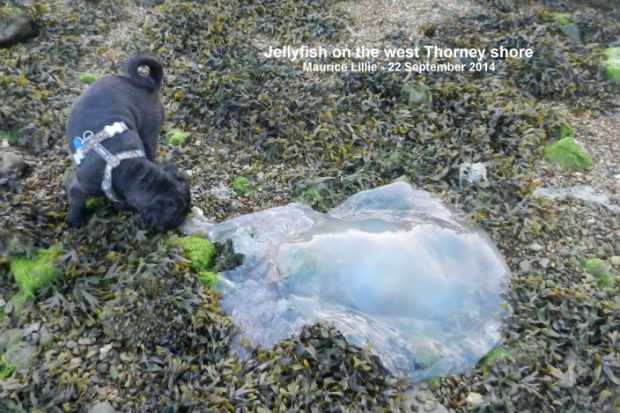
Hampshire
Farm
Chris Oakley
reports from the Hampshire Farm open space site:
"A beautiful warm afternoon with a light wind. The
reserve is now settling into autumn with very few
flowers left. I came across a Common Lizard sunning
itself on one of the log piles. The Clouded Yellow
butterfly was still there, assuming it's the same one,
there were two Large Whites and a Speckled Wood. I
watched a House Martin followed by four Swallows all
flying north west against the wind.
Some days ago I had laid three refuge mats beneath the
hedge and today one produced this Shield Bug (Coreus
marginatus). I found one of these a few weeks ago over
on the east side. Of all the trees that were planted
around the site, the Alders are by far the strongest,
bursting out of their plastic tubes, the ground must
suit them. Most of the other varieties have survived
but are far from robust. On the way back, I was glad
to see a Little Egret by the pond but no Mallard
today."
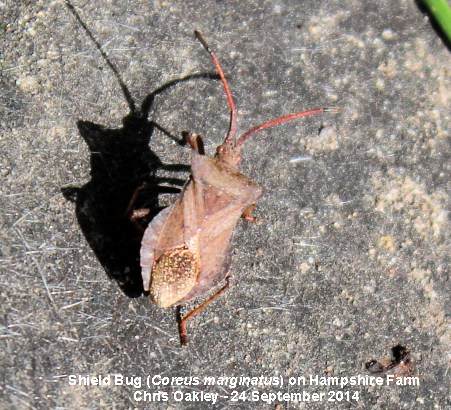
TUESDAY
SEPTEMBER 23 - 2014
Large
White
I have read
that all three white butterflies have not had a good
season this year. However, I have been seeing quite a
few over the past week or so in my garden, mainly
Large White and Small White. They are attracted mainly
to the flowers of Ivy and Verbena.
Today, I had a beautiful female Large White feeding on
the Verbena for about 30 mins around lunch time. It
was a cracker with gleaming white wings, broken by two
large black spots on the upper wing and an back wing
tips extending down the side of the wings. The male
Large White does not have the black spots.
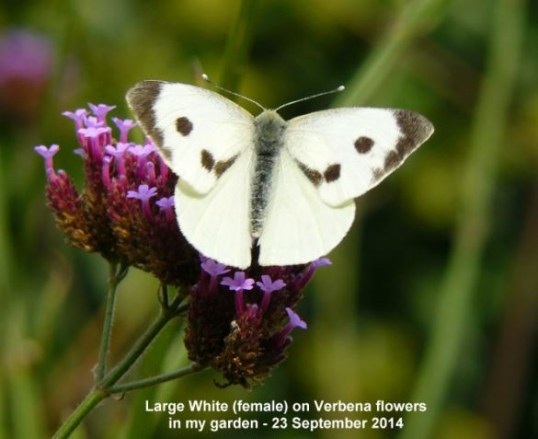
There are generally
two generations of adults a year, with the second
emergence in summer always the most numerous. The
markings on the wings are also darker in the summer
brood than in the spring one. The insects overwinter
in chrysalis form and the spring adults emerge in late
April and May.
Field
Grasshopper
John Arnott
(my 'resident expert Orthopterist') responded to Chris
Oakley's query about the grasshopper with the red
pronotum yesterday. John said Chris's photo showed a
female Field Grasshopper Chorthippus
brunneus and not a Meadow Grasshopper (though
Chris did e-mail me later to say the insect was a
Field and not a Meadow Grasshopper).
John went on to say the insect was a female because
the tip of the abdomen isn't curved up as in a male.
He attached a copy of Chris's photo with five features
arrowed which, in combination, confirm the
identification of Field Grasshopper.
Here it is as a pdf file . . . field-grasshopper-labelled.pdf
As for the colouring
of the insect John says quite a few of our grasshopper
species are very variable in colour and pattern, so
these are often of little help in identification. The
Field Grasshopper is particularly variable in both
males and females. Twelve colour/ pattern categories
have been identified with considerable variation
within each. John says Chris's grasshopper is
'category 8' described as Purple, Brown Sides, where
the dorsal surfaces of the head and pronotum (the
saddle shape behind the head) are purple. The adult
colours don't change with the season.
John also provided a link to a useful website
grasshopper species accounts and sound files of
'songs', some using bat detectors. www.orthoptera.org.uk
Regarding the use of
bat detectors with grasshoppers, John attached a
document which he thought might be of interest about
the use of songs in identification of bush-crickets in
particular. . . . orthopterists-bat-detectors.pdf
.
John took his bat
detector onto Brook Meadow again on Saturday (Sep 20)
and walked through the south meadow where on this
occasion there was no sound at all on the bat detector
while passing through the area so deeply flooded last
winter (though there had been some there when he
visited on 12th September). However, as he mounted the
bund by the seat "the detector came alive in my hands
as it picked up all the Long-winged Coneheads in the
long grass ahead. It was just like entering a room
full of people all chattering away to each
other".
MONDAY
SEPTEMBER 22 - 2014
BROOK
MEADOW
Water Rail
As he walked
by the fallen trees just before the S-bend Malcolm
thought he caught sight of Water Rail. Determined to
confirm the sighting he stood there for over an hour
and finally got a couple of photos of the bird as it
emerged from hiding. What patience this man has!

This was our first
Water Rail of the winter period on Brook Meadow and,
in fact, the earliest one we have seen here. This bird
could well be staying on the meadow for a while, as
has often happened in the past. Last year we had one
in the same area of the river by the S-bend for about
4 weeks from 17-Nov-13 to 14-Dec-13. Today's bird
could be the same one returning to a favoured spot?
Water Rails do pass through at this time of the year,
so, please keep a look out for any.
The
new wall
Malcolm
Phillips had an escorted trip to see the work on the
river containing wall which is being built at the
north east corner near the railway tunnel. The workers
are making good progress, though it will take another
couple of weeks or so to complete.

Hampshire
Farm
Chris Oakley
took a morning walk around the Hampshire Farm open
space area. It was perfect Grasshopper weather, sunny,
hot and no wind, and there were certainly plenty of
them. Chris says he has been coming across a lot of
the Meadow Grasshoppers with a red pronotum as shown
in this photo.
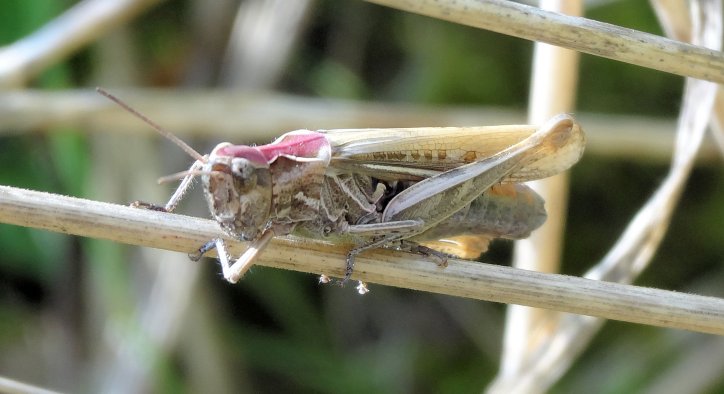
Chris can't find any
information about this unusual aberration (if that is
what it is) or illustrations of grasshoppers with this
red colouring. I will consult our 'resident'
Orthopterist.
SUNDAY
SEPTEMBER 21 - 2014
Warblington
shore
Peter
Milinets-Raby was up at first light to visit the
Warblington shore yesterday (Sep 20) 6:48am - one
minute after sunrise to 8:41am - tide pushing in. The
highlights were as follows:
Ibis field: 1 male, 6 female type Pheasant, 1 Moorhen,
3 Yellow Wagtails over, 6 Meadow Pipits over.
Hedgerow behind Conigar Point: 2 Chiffchaff, 7 Stock
Dove.
Conigar Point: 65 Teal in eclipse (one male beginning
to get green head markings), 2 Pintail in eclipse, 2
Wigeon in eclipse, 2 Black-tailed Godwit, 1 Lapwing, 6
Grey Plover, Redshank 15+ ( -//B+B//WR and -//B+B//OL
and -//B+B//ON ), 2 Bar-tailed Godwit, 4 Dunlin.
Pook Lane: 8 Black-tailed Godwit, 5 Greenshank, 19
Brent Geese flew east down the channel towards
Emsworth, 5 Grey Plover, 15 Teal in eclipse, 1 Wigeon
in eclipse, 1 Sandwich Tern, Redshank 75+ ( -//B+B//RR
), 2 Dunlin, 1 Lapwing, Spotted Redshank heard on
three occasions, but could not locate, 90
Oystercatcher in pre-roost gathering.
Langstone Mill Pond: 7 Teal in eclipse, 3 Shoveler in
eclipse, Chiffchaff singing.
SATURDAY
SEPTEMBER 20 - 2014
Malcolm's
news
Malcolm
Phillips went down Thorney this morning where he got a
photo of what is probably a juvenile Stonechat on the
wire fence. However, I am not 100% sure about this
one. Anyone help? Peter Milinets-Raby thinks it is a
Wheatear. The white rump is a give-away.

Malcolm then walked
over to Nore Barn where he captured these two House
Sparrows feeding on the Tamarisk on the shore. No
doubt about this one!
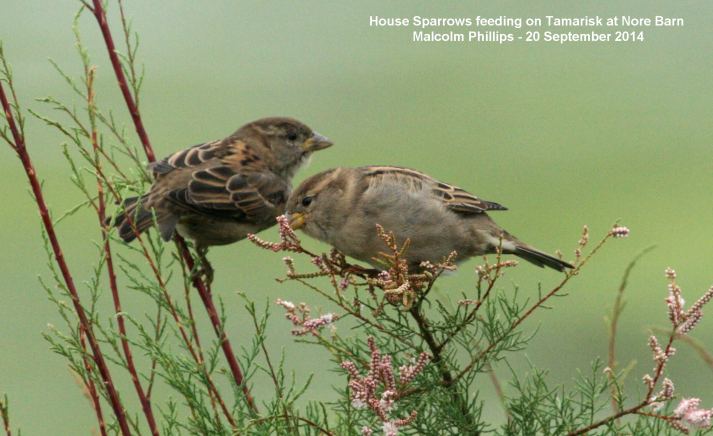
Swan
rescue on Canoe Lake
Yesterday (Sep
19), Jackie-Michelle Daines made a dramatic rescue of
a pen Mute Swan on Canoe Lake Southsea which had a
fishing hook embedded in the upper part of her beak.
The hook was attached to a lead weight and 20 foot of
nylon line with a plastic handle at the end. The line
was wrapped around the neck of the swan and also
around one leg. The poor animal was going mad trying
to get the line off, but with no chance as the hook
was fully through the top part of her mouth. Jackie
phoned the RSPCA for help and was told an officer was
on way but after 20mins with no sign of anyone and
with the swan getting more and more distressed, Jackie
decided to take action herself with the help of her
friend Rose and another member of the public.
I let Jackie take up the rest of story:
"I approached the swan on my knees talking softly to
it and with out-stretched hand. The swan did not back
off or go defensive she just lightly pecked my hand
with no power. I could now see the hook was clean
through the upper jaw and was barbed. At this point I
asked if anyone had a large pair of nail cutters I
could borrow. A young girl had a pair. The swan was
very carm and just kept tapping my hand with her beak
so I took a chance and took hold of both closed wings
as I had been shown when I attended the Thames Upping
this year, not that I had ever tried this before, but
the swan remained calm.
I then gently sat over her and took hold of her neck
and used the nail cutters to cut the fishing line
attached to the hook and slowly untangled the swan.
This just left the hook. The hole in the beak had been
enlarged with her fighting the line for 20min so I had
no option but to take it out the same way it went in.
As I did this the swan did not show any sign of pain
and at no time did she attempt to fight me. She seamed
to know I was helping her.
I made sure all the line was removed before releasing
the swan to a cheer from a crowd of people that had
gathered. I was too involved to notice them until
then. Finally, the swan stood up and stretched her
wings before returning to the lake. She did not move
off but went up to her mate before they both came back
to where I was standing. Both her and her mate then
vocalised to me before they moved off.
About 20mins later the RSPCA officer arrived and I
informed him as to what had happened and showed him
the hook and line (photos attached). He took a look at
the swan from the bank of the lake and thanked me for
saving the bird. I would not normally take this action
or recommend it to anyone else but, as confirmed by
the RSPCA officer, in this case it was the right
move."

FRIDAY
SEPTEMBER 19 - 2014
Brook
Meadow
Malcolm
Phillips was out on the meadow early this morning. He
saw two Kingfishers, one at the top of Peter
Pond and another by the fallen trees just before the S
bend. But could not get close enough for a photo.
However, Malcolm was determined to get a Water Vole
and was rewarded following a long vigil on the
south bridge with a nice view of one feeding. Thank
goodness they are still there! It has been almost a
month since we (ie Malcolm) had the last sighting.
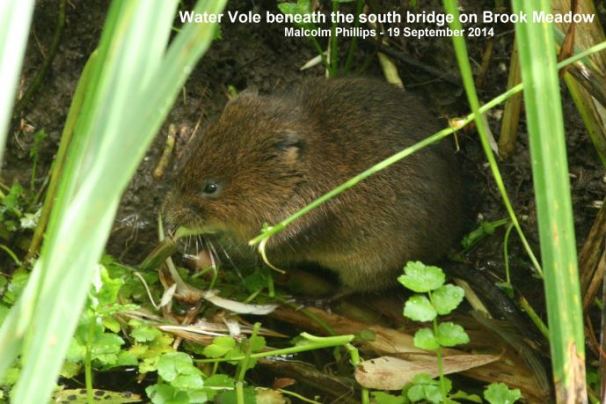
Malcolm gets some good
bird photos from the Rowan plantation. He captured the
following images of an acrobatic Magpie and a
young Blackbird plundering the berries which
have been abundant this year, but which are
disappearing rapidly. There will certainly be none
left for any Waxwings!
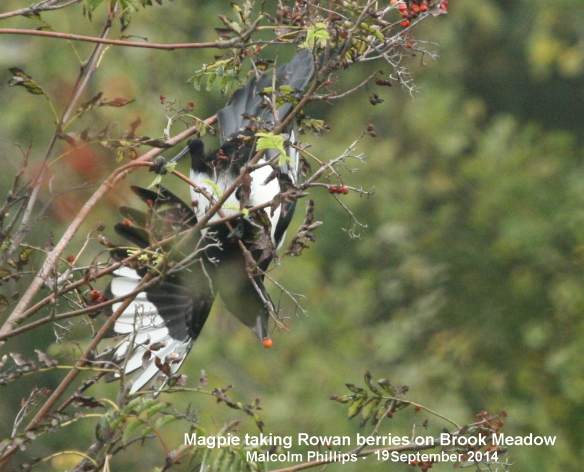
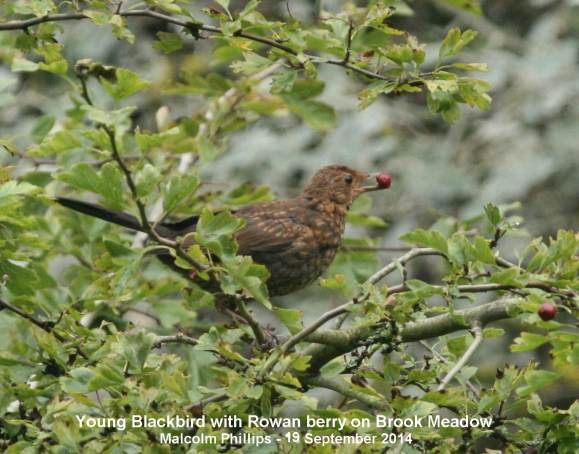
Hampshire
Farm
Chris Oakley
was back on the Hampshire Farm open space area today
after a period of illness. He found several young
Mallards on the pond and was wondering if they were
the ones that disappeared some months ago. Possibly,
but there must be a lot of them around. However, Chris
saw no Swallows or House Martins which have been
regular over the summer. They will not have left on
migration just yet, but it won't be long.
Chris says the hedge fruits are at their peak with the
Sloes the best he has ever seen them. They make
nice wine, if you have the patience! Hazel is already
showing small green catkins.
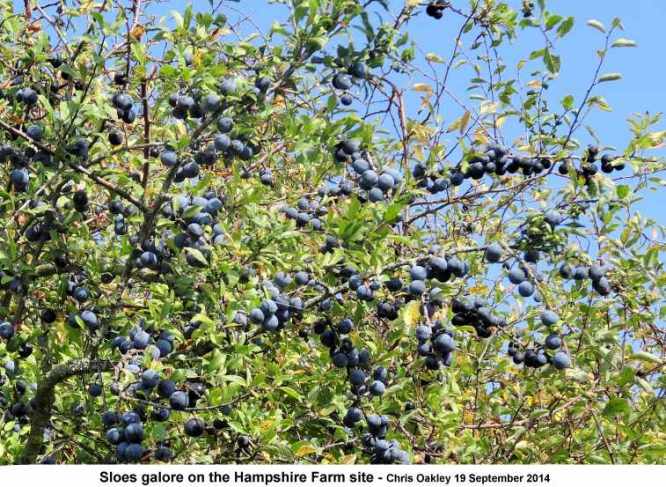
The grass is greening
up well and many flowers are reappearing. Fleabane on
the reserve is fading but the Bristly Ox-tongue is
back in flower with a vengeance. Crane flies are
everywhere and the Common Darters are still
abundant.
A young Buzzard has appeared and Chris is hoping it's
an offspring of the resident pair. However, Chris is
puzzled by the general lack of birds on the Hampshire
Farm site. Most of them will be keeping their heads
down at this time of the year as they will be
moulting. Winter should see an increase.
THURSDAY
SEPTEMBER 18 - 2014
Brook
Meadow
I went over to
the meadow this morning mainly to take photos of the
conservation work session. I noted that the main paths
through the meadow had been strimmed by the council.
That's a good job done.
The north path is closed for work which is taking
place in the north-east corner to build up the river
bank and wall to prevent future flooding. This work is
likely to take 3 weeks.
The main task for the work session was to begin
clearance of the vegetation that had engulfed the
Seagull Lane patch over the past year. The power
scythe was used for the main cutting work, while the
rest of the group raked and cleared away the arisings.
The Jubilee hedgerow was also clipped, though it will
need a more thorough management in the future.

Brimstone
A bright
yellow male Brimstone butterfly was fluttering around
the Seagull Lane patch during the work session. We
usually associate the Brimstone with early spring as
the hibernating adults emerge to look for mates and
egg-laying sites. However, there is always a late
summer brood which will be preparing themselves for
hibernation by gorging themselves on nectar, sometimes
well into October.
Emsworth
Harbour (west)
11:00 - Tide
still falling, very slow to go out today. It was a
very low neap tide at 3.7m. I counted 34 Teal on the
mudflats, well spread out, not clustered like they
were yesterday. But, the most interesting sighting was
a pair of Wigeon in the channel near to Nore
Barn, the first of the year in Emsworth.
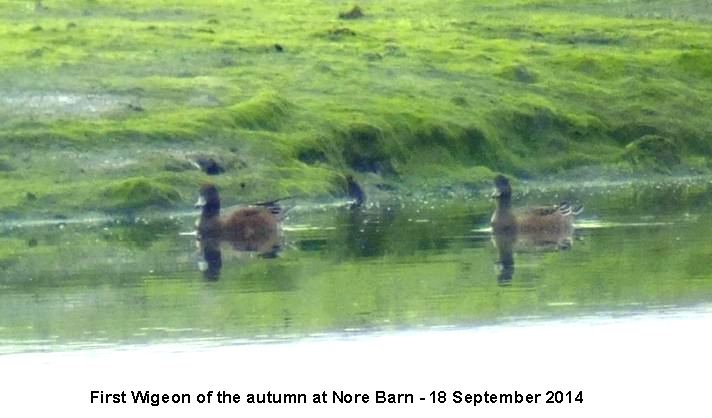
Warblington
shore
Peter
Milinets-Raby went down to Pook Lane via the Wade
Court access route this fternoon at 1:24pm to 3pm -
low tide. The highlights were:
16 Long-tailed Tits along horse paddocks with 2+
Chiffchaff, 6 Grey Herons resting on the salt marsh
(unusual sight - see photo of five), 27 Knot (best
count so far), 4 Greenshank (G//R+OO//-), 43
Bar-tailed Godwit (3 still in brick red summer
plumage, with at least 7 in washed out rosy plumage),
7 Grey Plover, 17 Dunlin, 1 Ringed Plover, 4
Black-tailed Godwit, 3 Curlew Sandpiper (all Juvs -
very elusive in the gullies), 60+ Redshank
(-//B+B//ON), 10+ Meadow Pipits moving over
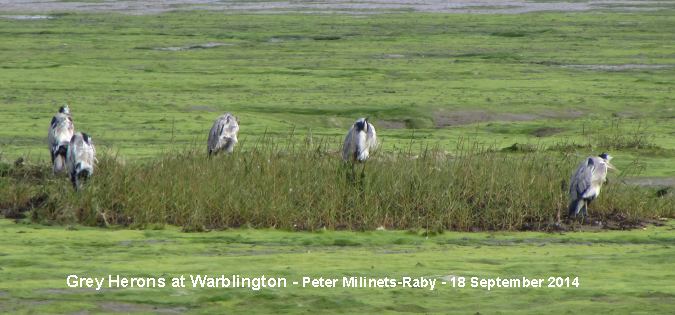
WEDNESDAY
SEPTEMBER 17 - 2014
EMSWORTH
HARBOUR
I spent a
couple of hours from 09.30 to 11.30 at the harbour on
a falling tide. High water was at 06.30. The weather
was warm and sunny with a cool northerly breeze. I had
some exciting sightings!
Teal
arrivals
09:30 - I
started at Nore Barn where I noticed two Teal in the
channel south of the woods - the first of winter
migrants. However, when I scanned across the western
mudflats I spotted another large flock of over 100
Teal feeding together to the west of the Emsworth
Sailing Club building. They were all in eclipse
plumage but the green speculum on the ducks confirmed
the identification.
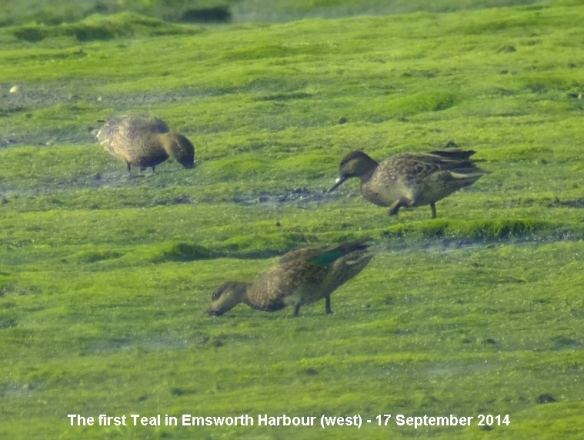
Redshank
galore
10:30 - Over
to the eastern harbour. The first thing I saw when I
got onto the seawall was Redshank everywhere! There
must have been a big arrival overnight. They were not
easy to count as they were spread all over the harbour
and constantly on the move. My best count was 234
which is the highest Redshank count for Emsworth in my
records. The previous best was 178 in Oct 2008. I
spotted just one colour-ringed Redshank:
BTO//B+B//RW This was the same bird I saw here
yesterday.
New
colour-ringed Greenshanks
There were
also plenty of Greenshank in the harbour. There was a
little group of six quite close to the shore including
four colour-ringed birds. There must have been at
least another six Greenshank in the harbour, some with
rings. I only managed to get one definite
colour-ringed combination:
G+GG - I do not have any previous records of
this combination.
Anne de Potier comments that G+GG was ringed 8
September 2013, not seen again that year and it's only
just come back. Anne first saw it on 10
September.

Malcolm Phillips got a
photo of another colour-ringed Greenshank in the
Slipper Mill basin (immediately south of Slipper
Millpond) that I have no record of either: G+YB
- Anne de Potier comments that G+YB is a newly ringed
bird.
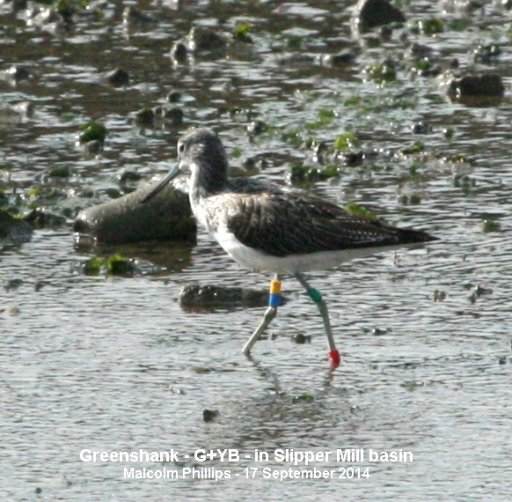
Godwit
'Old friend'
As yesterday,
there were very few Black-tailed Godwits in the
harbour (just 16). But they did include an 'old
friend' back for the first time this autumn.
WO+LWflag - This bird was ringed as a chick in
north Iceland on 13th July 2010 by Ruth Croger and
Pete Potts. It is very distinctive due to its white
flag. It has been a regular early winter visitor to
Emsworth Harbour each year since 2010. This was, in
fact, my earliest autumn record of this bird in
Emsworth.
TUESDAY
SEPTEMBER 16 - 2014
Colour-ringed
Redshank
I went over to
the marina seawall at about 09:30. It was a fine sunny
morning and the tide was falling fast, in fact, it was
pretty well right out by the time I arrived. My main
objective was to see if any of the colour-ringed
Redshanks that Pete Potts and his team ringed at Black
Point on Saturday had made it over to Emsworth. Peter
Milinets-Raby saw eight of the newly ringed Redshanks
at Langstone yesterday, so I was hopeful.
I counted a total of 72 Redshank on the mudflats in
the eastern harbour. I went through them all, but only
found one colour-ringed bird. I was not sure what to
expect in the way of rings and was surprised to see so
many rings on the bird. It really was quite colourful
with the red legs as well.
It also took a bit of working out (from photos) where
the rings were located. However, I eventually came to
the conclusion that the bird I was looking at had four
rings, one on the left leg and three on the right as
follows: Left leg tarsus: blue. Right leg tibia: blue.
Right leg tarsus red over white (or possibly lime). I
am not sure how to describe this combination but will
stick with my standard manner until I hear to the
contrary. B+B-RW. This was the very first
colour-ringed Redshank I have ever seen!

I saw very few
Black-tailed Godwits - not more than 10.
I spotted a couple of our regular colour-ringed
Greenshank: G+BL geotag and O+YY geotag.
Other birds included 3 Grey Plovers, two in
full summer plumage, several Turnstones. Numerous
Swallows flying around over the shore.
Wheatear on the shore.
Re Redshank
ringing
Pete Potts informed me that the Redshanks were
col-ringed at Thorney (west deeps) on Saturday
13-Sep-14. About 60 were marked. All have combinations
as follows: BTO//B+B//xx . It is best to just write as
B+B//RW The // is the international convention for the
leg joint and telling tibia from tarsus.
MONDAY
SEPTEMBER 15 - 2014
Brook
Meadow
I had a walk
around Brook Meadow this morning in lovely warm autumn
sunshine. I happened to meet Ros Norton on the main
path by the river. She was heading towards Lumley Mill
to see the Chicken of the Woods fungus. We stopped for
a while to look at the small creatures on the nettle
leaves beside the path. They included a couple of what
I assume were Dock Leaf Bugs and a 'Nursery-web
spider' (Pisaura mirabilis) with its
front legs typically stretched out.
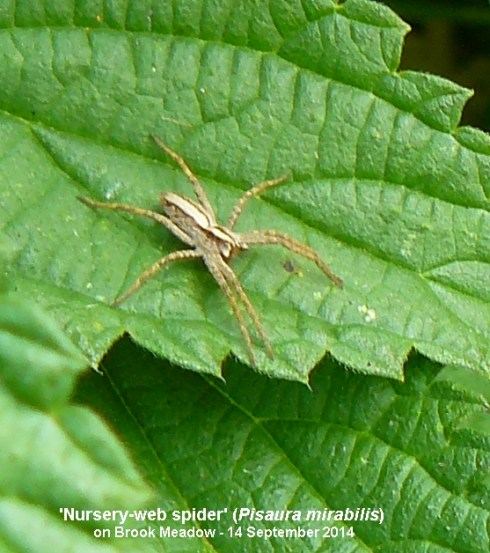
Horse
Chestnut
I also met
Brian Lawrence whom I had not seen for a while. He was
sporting a replacement camera for one that was faulty.
We were interested to see the great crop of conkers on
the Horse Chestnut tree near the Lumley gate. They are
such beautiful nuts that I can never resist collecting
some. I recall spending many hours as a boy selecting
and preparing my best conkers for the battles ahead.
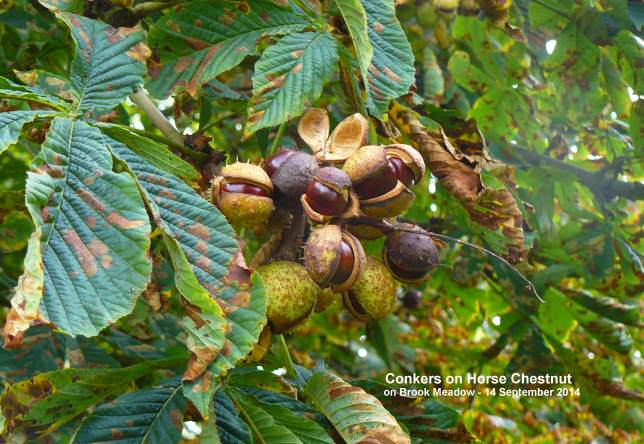
Brian and I noted how
the tree's leaves were badly affected by the leaf
miner moth. The larvae of this moth (Cameraria
ohridella) eat their way through the inside of
the leaves causing browning between the veins. The
larvae can easily be seen (and felt) as dark lumps in
the leaf. Despite the poor appearance of the trees the
Forestry Commission say there is no evidence that
damage by the moth leads to a decline in tree health
or tree death. It appears that the damage caused by
the grubs occurs too late in the growing season to
greatly affect tree.
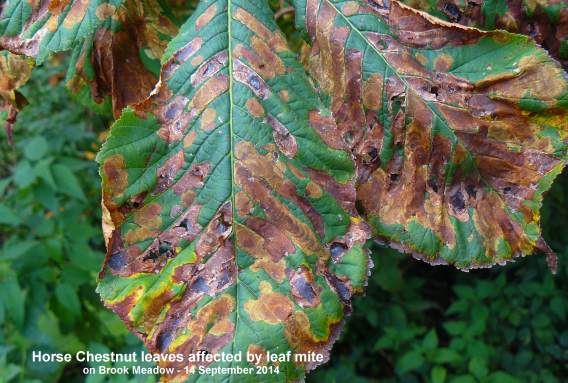
We were surprised to
quite a few sticky buds on the Horse Chestnut, which
we normally associate with spring time. However, I
gather they do commonly develop in winter.
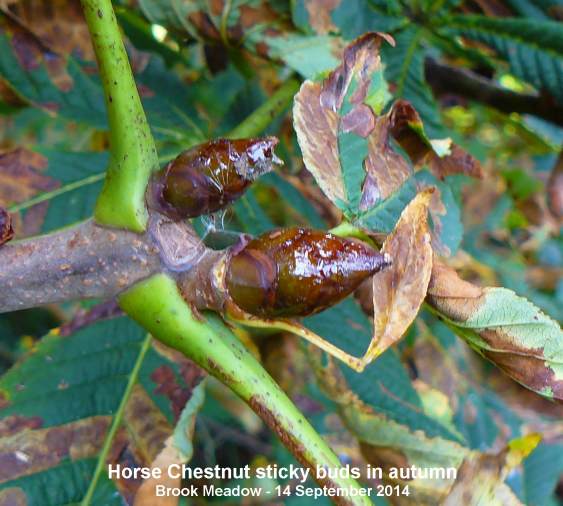
Long
Hoverfly (Sphaerophoria
scripta)
There were lots of insects feeding on the Common
Fleabane flowers which are still very bright and
cheerful. One insect that caught my eye was a tiny
hoverfly with yellow bars across a long black abdomen.
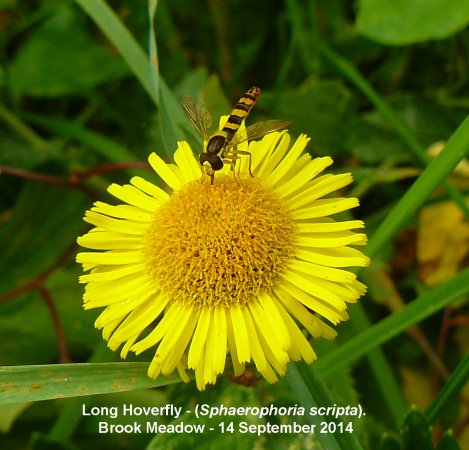
I recall having seen
this fly once before on the Railway Wayside last year
(June 24, 2013). I think it is a male Long Hoverfly -
(Sphaerophoria scripta). The insect gets its common
name from the fact that the male shown here has a body
longer than its wings. It is common over much of
Britain.
Spiders
There were
lots of Garden Spiders sitting in the middle of their
orb webs strung across the vegetation. I spotted
several with prey including this distinctive hoverfly
(Helophilus pendulus) which was yet to
be wrapped up.

Other
observations
I heard
snatches of song from Great Tit and Wren in addition
to Robin A pair of Moorhens was in the river by the
S-bend; they probably had youngsters, but I could not
see them. Some of the Hogweed flower heads were pick
tinged as they tend to at this time of the year.
Creeping Buttercup is in flower. False Oat-grass is
now starting to flower again.
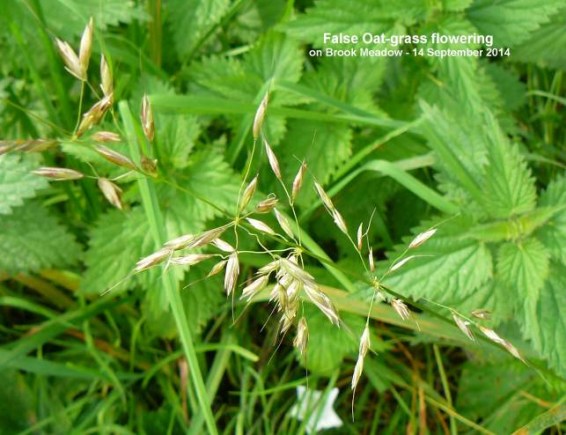
First
Brent Geese
Ralph Hollins
got a sighting of a group of 11 newly arrived Brent
Geese in Langstone Harbour on Friday 12 September.
Brents have also been seen at Rye Harbour and
Pennington near Lymington. Ralph thinks that all these
early arrivals are heading for the west coast of
France and that it will be some time before birds
begin to settle on our south coast.
Common
Darters
Joyce Sawyer
and her husband were lucky to get this nice view of a
pair of Common Darters mating. We have had lots of
Common Darters on the blog, but not one of their
mating as far as I am aware. Nice one.
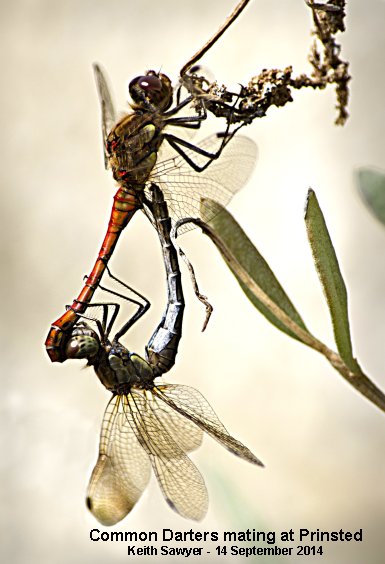
Langstone
Mill Pond
Peter
Milinets-Raby managed a quick one hour visit this
afternoon to Langstone Mill Pond (1:35pm to 2:38pm):
Off shore ahead of the incoming tide were the
following:
9 Greenshank (G - R/BRtag -) off Pook Lane. 7 Adult
winter Sandwich Tern on the mud by the pub. 11 Dunlin.
2 juv Curlew Sandpiper (swimming as the water rose,
before finally flying off towards Thorney). 9
Black-tailed Godwit, 3 Grey Plover, 38 Bar-tailed
Godwit, Common Tern, 8 Eclipse plumaged Teal on the
Pond with a single Shoveler. Kingfisher heard and 3
Grey Herons with 47 Little Egret. No sign of this
Great White Egret that keeps getting reported flying
east over Langstone Harbour!!!
And finally, 263 Redshank (best count so far
and loads with coloured rings - fresh from Saturday's
ringing session which I missed out on due to DIY job!)
- B/B - BY, - B/B - WW, - B/B - OL, - B/B - LN, - B/B
- ON, - B/B - WL (though the WW bird could have been
this), - B/B - BN, - B/B - GN.
SUNDAY
SEPTEMBER 14 - 2014
Railway
Wayside
I had a walk
around the wayside to the north of Emsworth Railway
Station this morning. There was a profusion of wild
flowers, on show most of which could be seen easily
from the access ramp.
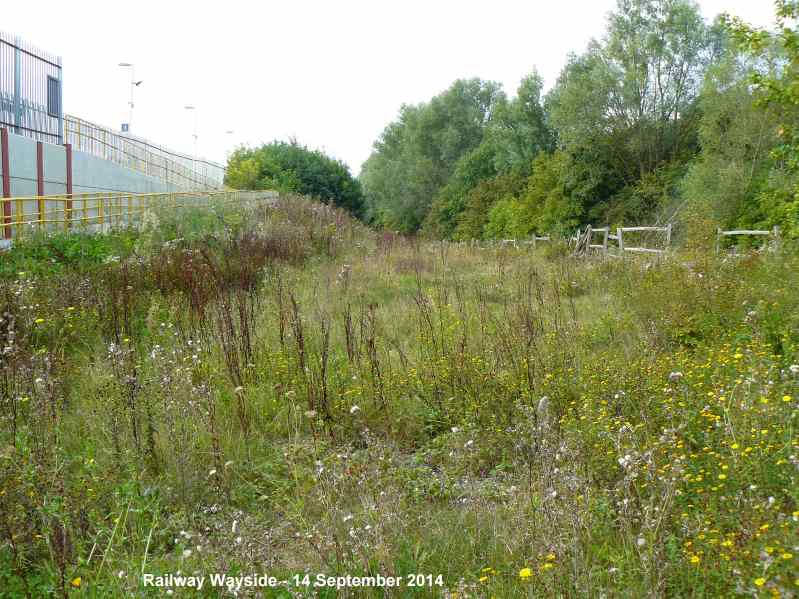
They included Marsh
Woundwort, Hoary Ragwort, Common Fleabane, Bristly
Ox-tongue, Common Knapweed, Yarrow, Red Bartsia,
Creeping Thistle, Hedge Bindweed, Nipplewort, Great
Willowherb, Spear Thistle, Bittersweet, Common Field
Speedwell, Knotgrass, Smooth Hawk's-beard, Black
Medick, Canadian Goldenrod, Perennial Sow-thistle,
Cat's-ear, Wild Carrot, Red Clover, White Clover,
Scentless Mayweed, Prickly Lettuce, Scarlet Pimpernel
, Ribwort Plantain, Guernsey Fleabane (in bud),
Perforate St John's-wort (in seed).
At the eastern end of the highways track near New
Brighton Road, I found the usual good flowering of
Redshank and some Marsh Cudweed and Toad Rush
in much the same area as last year, at the base of the
mound of soil.
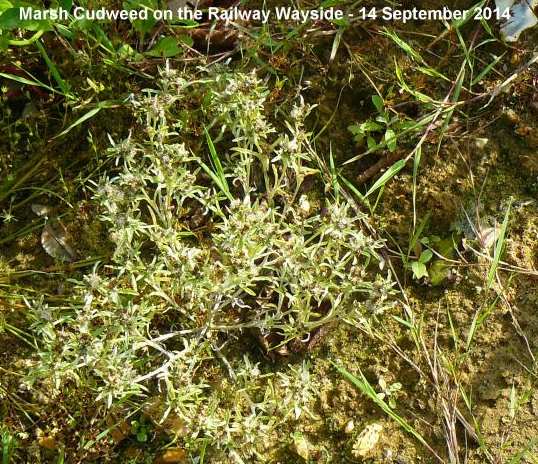
Several Common
Blues were fluttering around, occasionally
settling on flowers for nectar. From what I could see
most were in reasonably good condition.
I came across what
looked like an unusually large female Common
Darter resting on the wooden fence. Maybe, I had
judged it size wrongly as it could not have been
anything else. From the colour of its abdomen my
dragonflies guide describes it as an 'over mature'
female.
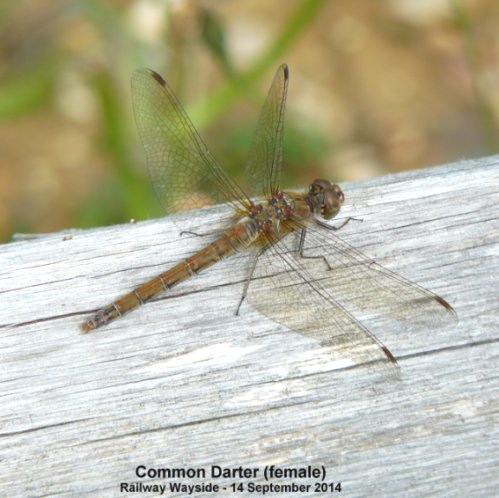
Warblington
shore
Peter
Milinets-Raby was out this morning for a walk along
the Warblington shore via the cut sweet corn fields
(6:51am to 9:11am - a very, very low tide). The
highlights were as follows:
Ibis Field: 2 Chiffchaff.
Hedgerow along the sweet corn fields: 2 female type
Blackcap, 1 Whitethroat, 2 Chiffchaff.
Tamarisk Hedge: Cetti's Warbler singing three times, 2
Chiffchaff (one singing).
Flying over: 3 Ind. Meadow Pipit, 2 Ind. Yellow
Wagtail, 1 Grey Wagtail, 128+ Swallow, 93+ House
Martin.
Conigar Point: 2 Greenshank (G - R/BBtag - ), 3 Grey
Plover, 5 eclipse plumaged Teal, 2 Lapwing.
Pook Lane (too distant to see the waders properly), 9
Knot, 44 Bar-tailed Godwits (4 still in summer
plumage), 5 Greenshank (G - R/BRtag -), 10 Grey
Plover, 11 Dunlin, 13 Black-tailed Godwit.
Langstone Mill Pond: 2 eclipse plumaged Shoveler, 10
eclipse plumaged Teal,
Off shore on the mud were 2 winter plumage Sandwich
Tern
Best
photo of one of the Curlew Sandpiper typically feeding
in the deep gullies off Pook Lane.
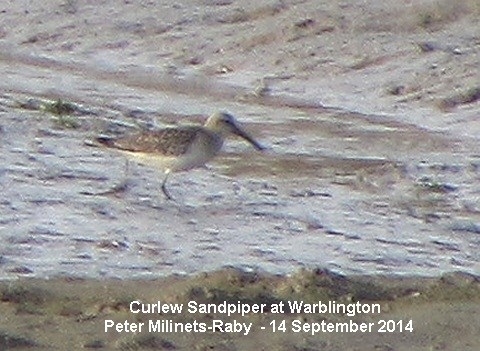
Masses
of Starlings
Malcolm
Phillips walked from Emsworth to Warblington today and
came across this great spectacle of Starlings massed
on the overhead electricity cables.
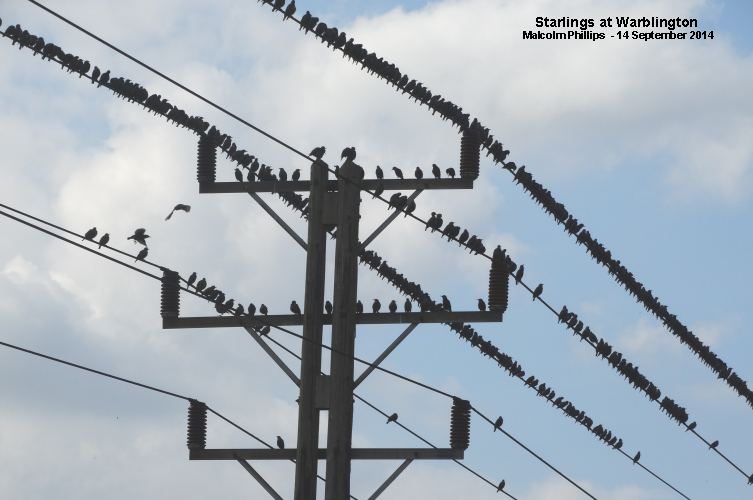
Sparrowhawk
takes Goldfinch
Patrick Murphy
witnessed a Sparrowhawk take a Goldfinch in his garden
this morning and got this fine image of the hawk with
its prey. Patrick said the hawk is a regular visitor
and normally comes at lunch time but clearly decided
to try his luck earlier.
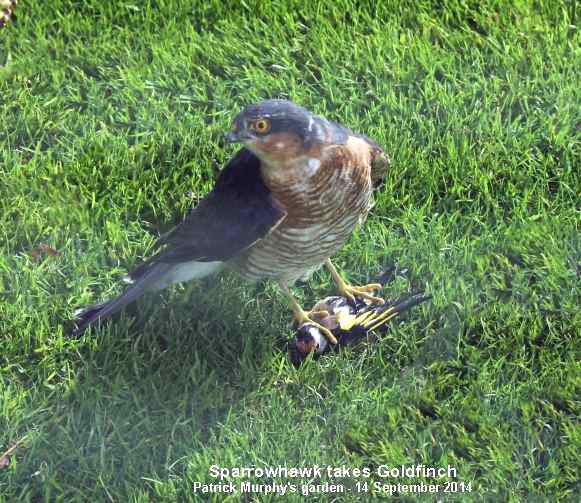
SATURDAY
SEPTEMBER 13 - 2014
Brook
Meadow - Bush-crickets
John Arnott
walked around Brook Meadow on the evening of Thursday
11th September between 18:00h and 19:00h with his bat
detector to check up on bush-crickets.
John's report: "All
the long grass areas across the reserve were full of
Long-winged Coneheads. Even more numerous were Dark
Bush-crickets on the Bramble patches everywhere. There
were some Speckled Bush-crickets around but not many.
They give a quiet tick at 40 kHz roughly every four or
five seconds but being so quiet they may be more
widespread than I found on the reserve. The north-west
corner along the river path was the best place, with
around 4 or 5 stridulating. Finally, there was one
brief Roesel's Bush-cricket on the west side of the
north meadow. All of these were heard on the detector
at 25 kHz (apart from the Speckled Bush-cricket).
I didn't actually see any of these animals, though I
spent a lot of effort trying to. That's the advantage
of a bat detector. I used to be able to hear Dark
Bush-crickets and Roesel's Bush-crickets with the
unaided ear but at age 68 those times are now
past!"
Here
is a Long-winged Conehead that Malcolm Phillips got
recently on Brook Meadow
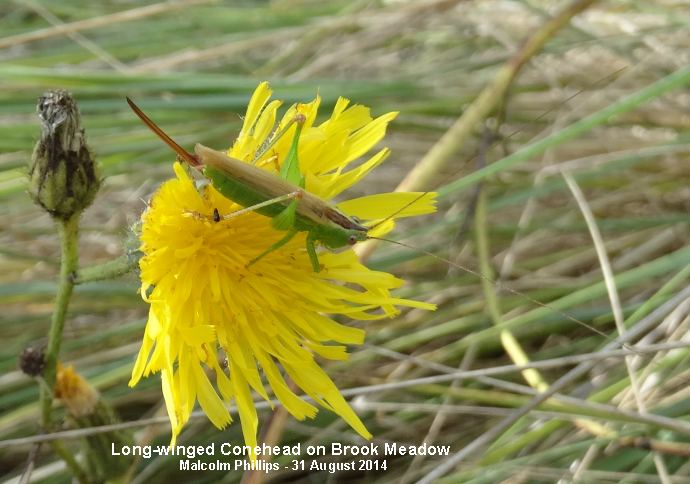
John ran a brief
survey for Orthoptera with the Chichester Natural
History Society at Medmerry for the RSPB last Friday
afternoon and was able to locate Long-winged Coneheads
by using the bat detector to triangulate on their
stridulation. Their density was lower there and
walking through the long grass was easier, so it was
possible to do this. Consequently he was able to watch
a male stridulating on a grass stem while listening to
it on the detector and managed to get a photograph of
it too. The females of bush-crickets don't stridulate
of course, but one of the members did catch a female
Long-winged Conehead in a sweep net.
FRIDAY
SEPTEMBER 12 - 2014
Emsworth
Harbour
10:30 to
11:00. - I had a look at the eastern harbour from the
marina seawall from. The tide was rising to high water
in about 4 hours. I counted 37 Black-tailed Godwits
none appeared to be colour-ringed. One of the
Godwits appeared to have a shell attached to its left
foot causing it to limp. I have come across this
problem before when a wader puts its foot into an open
mollusc which then closes. I gather the mollusc
eventually falls off when it needs to feed.
There were 5 Greenshank in the town channel,
but just as I got my scope on them to check for
colour-rings four of them flew off towards Thorney.
The fifth bird had colour-rings G+BL with
geotag. I last saw this bird here last spring on
09-Apr-14. It has probably been away to its breeding
grounds in the meantime and is now back 'home'.
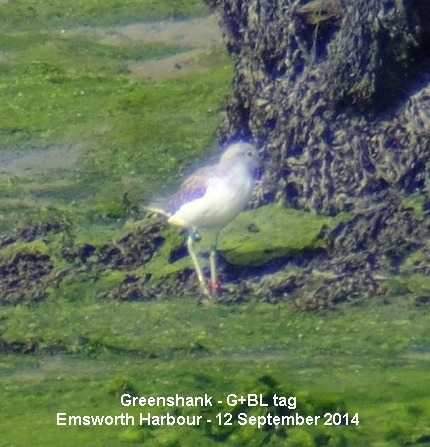
Ivy
flowering
Yesterday,
Ralph Hollins drew my attention to the start of
flowering for Ivy. This is always a significant event
in the natural calendar as Ivy flowers provide the
best nectar source throughout the winter for late
flying insects. The large Ivy hedge at the end of the
Western Parade footpath to Nore Barn was in flower
when I passed by. The flowers were being visited by a
variety of flies, bees and hoverflies. They also
attracted a Hornet, though it did not stop for a
photo! All I could get was a Green-bottle fly.
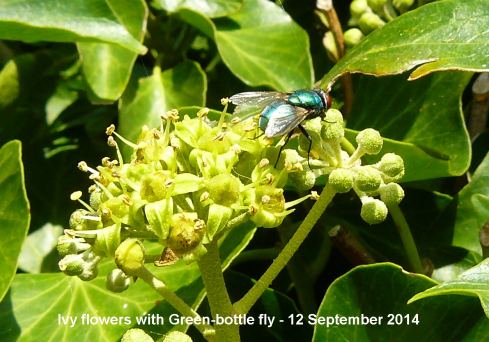
Whinchat
Malcolm
Phillips had a long day in the field today. He went
round the meadow this morning then down to Thorney
then back to the meadow this afternoon. While on
Thorney he got a rather fine photo of a Whinchat.
Whinchat is a summer visitor to Britain and probably
breeds on Thorney, though I suspect this one has come
from further north and is on its way to its wintering
quarters in West Africa.

Wasp
Spider
While on Brook
Meadow Malcolm came across this magnificent spider. It
is usually called the Wasp Spider due to its
resemblance to a wasp, though this is unfortunate as
it does not sting.
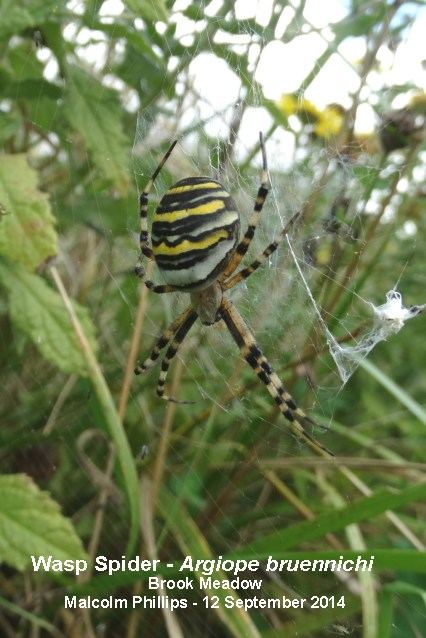
Some prefer the name
Golden Orb spider, as it is golden and builds a fine
orb web with a stabilimentum. Its scientific name is
Argiope bruennichi. This was our first Wasp spider of
the year on Brook Meadow, though they are seen almost
every year, usually in the autumn. Malcolm's spider is
a female, the male is tiny in comparison and I gather
probably gets eaten after mating.
Raven
over Emsworth
Tony Wootton
saw a Raven fly over his Emsworth garden. He said it
was quite high and going north, probably heading for
Stansted.
THURSDAY
SEPTEMBER 11 - 2014
Chicken
of the Woods
The first
thing I did this afternoon was to have a look at the
Chicken of the Woods fungus that Malcolm Phillips
found yesterday growing alongside the path from the
end of Seagull Lane to Lumley Mill. It is indeed a
magnificent specimen growing on an old pollarded
Willow inside the garden of Constant Springs near the
Lumley Mill end of the path. There is one huge fungus
and a smaller fungus growing on the same tree. They
can be seen easily but are completely inaccessible
behind the tall wooden fence. This is the first
Chicken of the Woods fungus I have ever seen in
Emsworth.

Hoverfly
- Helophilus pendulus
I had a little stroll around Brook Meadow this
afternoon. One of the first things I noticed was a
very distinctive hoverfly moving among the flowers on
the Lumley area. This must be the easiest hoverfly to
identify with the black and yellow longitudinal
stripes on the upper surface of its thorax.

However, I gather that
all Helophilus species have this feature, but none is
as common in Britain as H. pendulus. It
is sometimes known as the Sun Fly from its liking for
sunbathing. Its scientific name means "dangling
marsh-lover" (from Greek 'helo-, "marsh", -phil,
"love", Latin pend-, "hang"). It is a fairly common
hoverfly on Brook Meadow throughout the summer and
autumn.
Hoary
Ragwort
This
attractive plant is now in full flower on the north
meadow. It is not as prolific as in previous years.
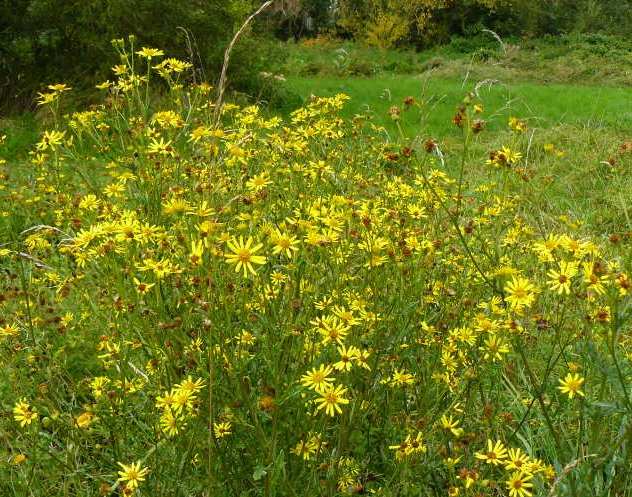
Hoary Ragwort is one
of the latest plants to flower on the meadow; it
rarely overlaps with Common Ragwort which flowers much
earlier. This is a good way of distinguishing between
the two ragworts. The flowers of Hoary Ragwort also
always appear brighter than those of Common Ragwort.
The leaves are also different with those of Hoary
Ragwort paler green, almost grey, and more deeply
lobed with the end lobe narrow and pointed. There is,
in fact, little, if any, Common Ragwort on Brook
Meadow.

Speckled
Wood
This was the
only butterfly I saw during my walk through the
meadow. It was flying around the open Lumley area,
which is unusual as one usually sees them in shady
areas by trees.

Unusually, the
Speckled Wood can hibernate as either a caterpillar or
a chrysalis, thus leading to a complicated sequence of
adult broods throughout the years.
Mother
of Pearl Moth
Malcolm
Phillips was also around Brook Meadow today and got
this excellent image of a moth, which I have
tentatively identified as Mother of Pearl. This would
be the first to be recorded on Brook Meadow.

Mother of Pearl is
said to be common in rural gardens, waste ground and
rough pastures throughout the British Isles. It is
widespread and common in Hampshire and on the Isle of
Wight. It wings have an opalescent sheen, most obvious
in sunshine, which gives rise to the common name. I
think Malcolm's photo captures this feature very
nicely. The larvae feed predominately on Common
Nettle, living within a spun or rolled
leaf.
Other
news
Malcolm also
saw two Kingfishers flying up the Lumley Stream
towards the mill.
When he got to the mill, Malcolm found the large
'goldfish' ie Golden Orfe, that he first saw
there on July 25th was still present.
WEDNESDAY
SEPTEMBER 10 - 2014
Emsworth
Harbour
I got to the
marina seawall at about 09.15 which was about 4 hours
before high water. I remained for about 45 mins as the
tide gradually pushed in. The Black-tailed
Godwits were fairly scattered around the mudflats,
with 16 on the shore in front of me and another 13 on
the town shore, making 29 in all. There were no
colour-rings.
I had a couple of colour-ringed Greenshank.
RG+BY tag - this was ringed on 19-Mar-13 with a
geo-tag on the blue ring. This was my 3rd sighting of
it this autumn.
OO+YY tag - Photo. OO+YY without a tag has been
recorded 11 times in Emsworth Harbour between Oct-07
and Oct-11, but not since then and never with a tag.
The tag was clearly on the upper yellow ring on the
left leg. I assume the tag was added in a recatch of
this bird? Sorry for the poor digiscoped photo but the
sun was very bright.

Other birds included
16 Turnstone, 12 Curlew. Hedgerow Crane's-bill is
still in flower on the marina seawall.
Nore
Barn
I got to Nore
Barn just after 10am with the tide still out but
rising. The regular unringed Greenshank was on the
edge of the stream, but no other waders. I stayed for
about an hour, but no waders turned up. Eight Shelduck
were in the far channel including some juveniles.
Workers were busy with the seawall restoration.
Robins were singing in woods and Speckled Woods flying
around, but nothing else of interest. Selfheal was
still in flower along the edges of the central path
through the woods.
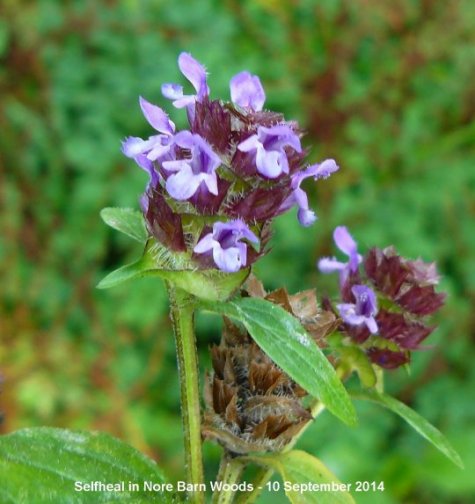
I had a look around
the saltmarshes to the west of the stream where I
found all the regular saltmarsh plants including
Common and Lax-flowered Sea-lavender, Sea Aster,
Golden Samphire, Common Glasswort, Common Cord-grass
(Spartina anglica), Annual Seablite, Sea Purslane, Sea
Plantain, Sea Beet, Sea Couch and Sea Wormwood.
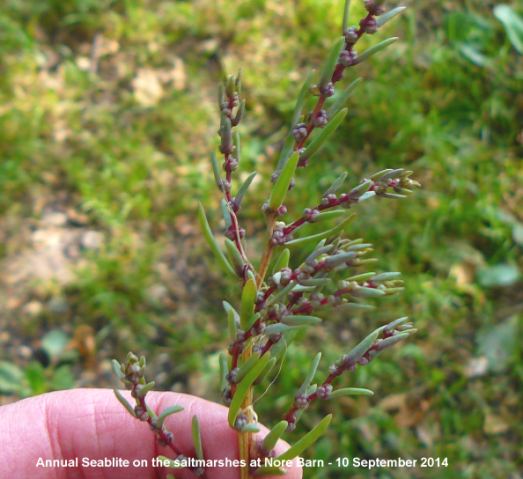
Chicken
of the Woods
Malcolm
Phillips discovered this magnificent collection of
bracket fungi growing on one of the trees (Willows?)
along the path from the end of Seagull Lane to Lumley
Mill. I have not seen the fungus myself, but it looks
like a very nice example of Chicken of the Woods (aka
Suphur Polypore).
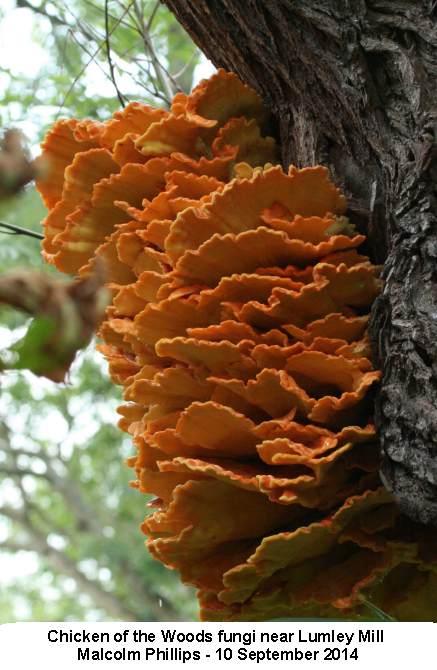
It is most commonly
found oak, but also on yew, sweet chestnut and willow.
The fungus is said to be edible, rather like chicken,
though take care since in some cases eating the
mushroom can cause nausea. So, it best admired from a
distance.
September
strawberries
Graham Petrie
sent me this photo of some fruit he found ripening in
his garden. Yes, stawberries in September.
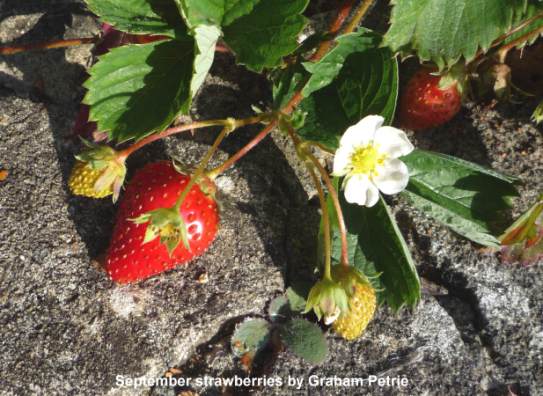
TUESDAY
SEPTEMBER 9 - 2014
Brook
Meadow
Malcolm
Phillips had a good catch on Brook Meadow this morning
with what appears to be mother and son Great
Spotted Woodpeckers. Here is what I assume to be
the mother with no sign of any red on the back of her
head.
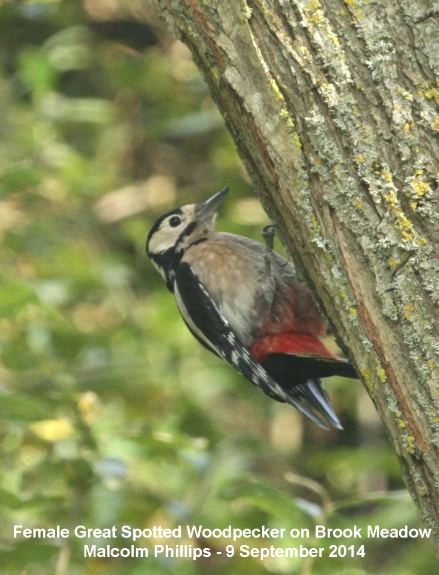
And here is the
juvenile with an all red crown, probably a male as a
female juvenile would have less red on its crown. This
is good news as it proves successful breeding of this
species on Brook Meadow.
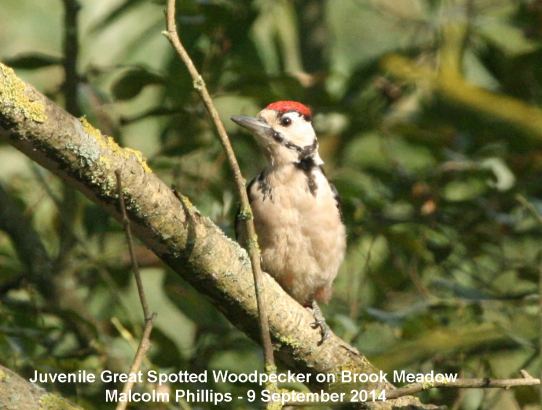
Malcolm also got a
fairly late and slightly battered Common Blue
butterfly. This will be the second brood; there is
sometimes a partial third brood in warm weather which
means the adults are seen into October.
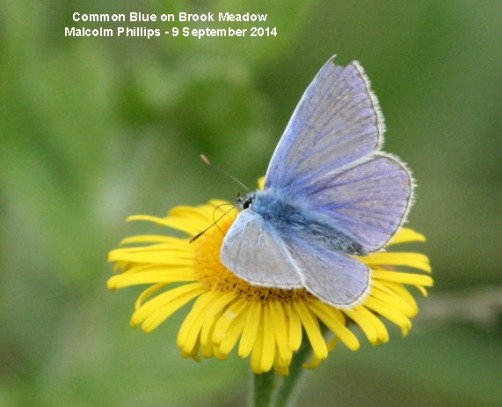
I was interested to
read about the relationship between the caterpillar of
this butterfly and ants. Hibernation occurs when the
caterpillar is quite small, among dead leaves. There
it attracts ants which eat its sugary secretions,
though they do not damage the creature. The pale green
chrysalis is formed on the ground and is often taken
into their nest by the ants.
MONDAY
SEPTEMBER 8 - 2014
Brook
Meadow
Malcolm
Phillips went round the meadow late this morning and
got some good images of insects, including this rather
fine Small Copper. We usually get the odd Small
Copper on the meadow each year at about this time, but
this was our first of 2014. It usually has three
broods and this will be an adult from the final one of
the summer. One can see one flying even into October.
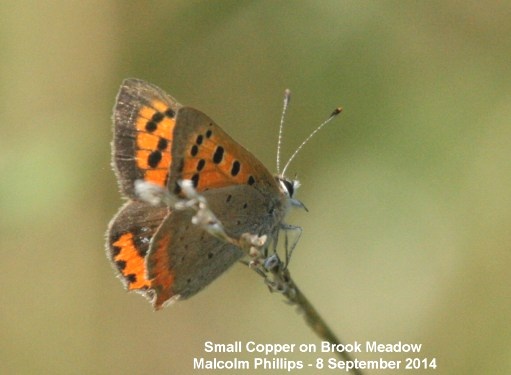
One of Malcolm's other
photos was this mature male Migrant Hawker
which is not uncommon on Brook Meadow at this time
of the year. It is slightly smaller than the Southern
Hawker which is also common on Brook Meadow, but
Southern Hawker has broad green antehumeral stripes
and predominantly green abdomen. This insect could
well have flown across the channel. There are regular
migrations of Migrant Hawkers from the continent which
increases the population in the our area in late
summer.

Garden
caterpillar
Chris Gibbs
had this magnificent beast turn up in his Church Path
garden near the centre of Emsworth. In fact, the
caterpillar is more often seen than the moth and its
large size is obvious on privet bushes - its main
source of food. It burrows into the ground and changes
into a chrysalis nearly 6 inches deep in the soil
where it can remain for up to two years before it
emerges.
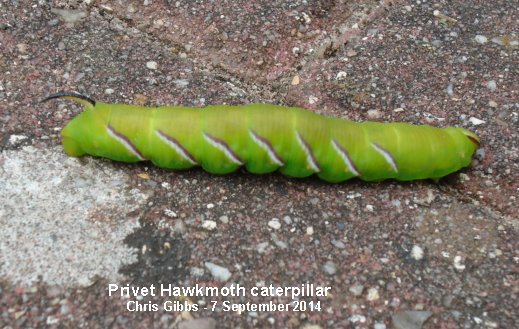
Sparrowhawk
in Garden
Patrick Murphy
had this fine male Sparrowhawk waiting in his plum
tree. Patrick took the photo through a venetian blind
but he thinks the bird must have noticed some movement
as it turned its head to look straight at the camera!
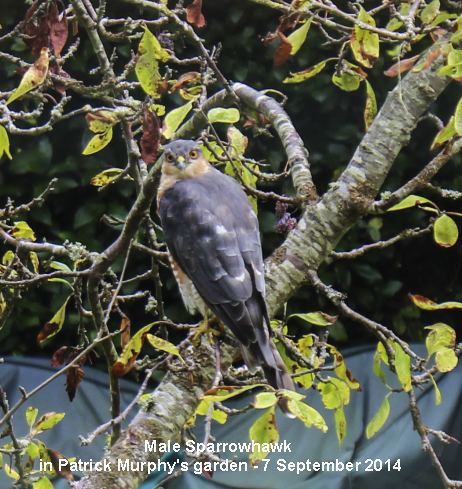
FRIDAY
SEPTEMBER 5 - 2014
Emsworth
Harbour
12:00 - About
3 hours after high water, so the tide was still well
in. From the millpond seawall I counted 55
Black-tailed Godwits on the town shore. They
included one colour-ringed bird: G+BG - This
has been fairly regularly in Emsworth Harbour over the
past 4 years. First sighting here this season.
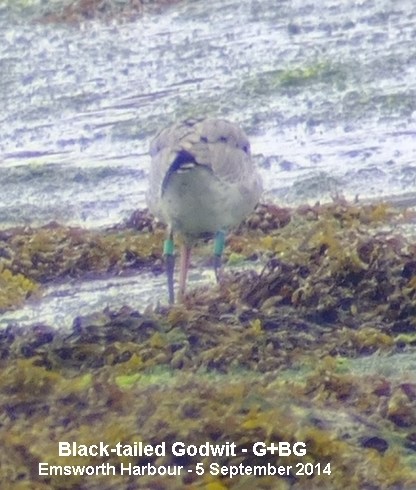
In 2011-12 it was
recorded right through the winter from Sep to Mar, but
usually it is only seen in autumn and early winter.
This was out 53rd sighting of the bird in
Emsworth.
Also in the mudflats were the regular flock of 8
Turnstone. The Godwits on the shore were disturbed
by a person rowing in the channel and they all flew
off in the direction of Thorney Island. I went over to
the marina seawall where I located what was probably
the same flock (and more) on the far mudflats off
Thorney, much too far for colour-ring sightings. I
counted 85 Redshank, 5 Curlew, 1 Greenshank and
an adult Lesser Black-backed Gull.
Brook
Meadow fungi
Malcolm
Phillips has been out taking photos of fungi. Of
course, he does not attempt to name them and I am
pretty hopeless when it comes to fungi, particularly
from photos. However, here is a fairly distinctive one
which someone might recognise.
Ralph Hollins obliges: He says, "This looks like what
is sometimes called the 'Yellow Cowpat Toadstool'
(Bolbitius vitellinus) which you can see
at . . . http://www.rogersmushrooms.com/gallery/DisplayBlock~bid~5589.asp
where the habitat is described as "on rotting straw,
manured grassland or wood chips" which would fit with
the photo."

Hampshire
Farm
Chris Oakley
reports that the cutters are back on the open space
area to finish off the cutting of the main grassland.
A once a year hay cut should benefit the wild flowers
for the following year. It will be interesting to see
what happens.
Chris found three Common Lizards and some
copper-coloured baby Slow-worms in the northwest
corner which is very rough with a good variety of
cover. He also came across a young Fox fast asleep
under the hedge, so got some 'cute 'shots.
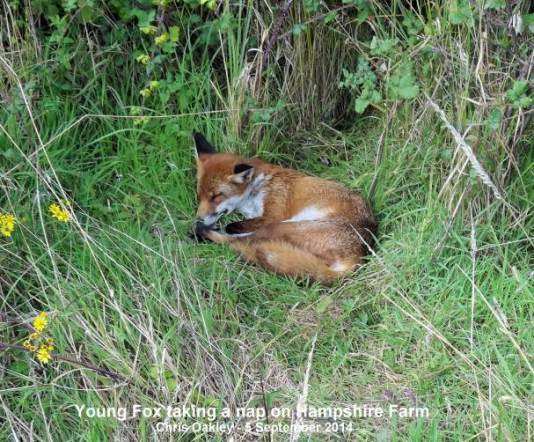
Of the insects Chris
saw a Clouded Yellow butterfly and Silver Y moth and
some Shield Bugs - probably Coreus marginatus - also
known as the Dock Leaf bug. Chris says it does have
the horns between the antennae; they are not easy to
see in this photo but blown up one of them is clearly
visible. That's an interesting pattern on the leaf
next to the bug.

Tony Davis comes to
the rescue by identifying the 'interesting pattern' in
the bramble leaf next to the shieldbug. He says, "It
is due to the leaf mine of the micro-moth
Stigmella aurella. The mine has recently
been vacated by the larva and will soon turn white.
You can see the old (white) mines in virtually every
bramble patch you look at."
Heronries
census
The BTO
Heronries Census in Sussex for 2014 and the last two
years has just been published, with numbers of nesting
pairs of Grey Herons and Little Egrets counted at each
heronry.
Locally, the one that stood out was the complete
abandonment of the Old Park Wood heronry this
year. The survey figures for this site were:
2012 - Grey Heron 5, Little Egret 14. 2013 - Grey
Heron 5, Little Egret 13. 2014 - Grey Heron 0, Little
Egret 0.
Old Park Wood is a privately owned woodland on the
Chidham peninsula which can be seen from Dell Quay
across the channel. I know Martin Baggs used to
monitor this heronry for many years, though I recall
him saying that the number of Heron nests was in
decline.
For
earlier observations go to . . Aug
17-31